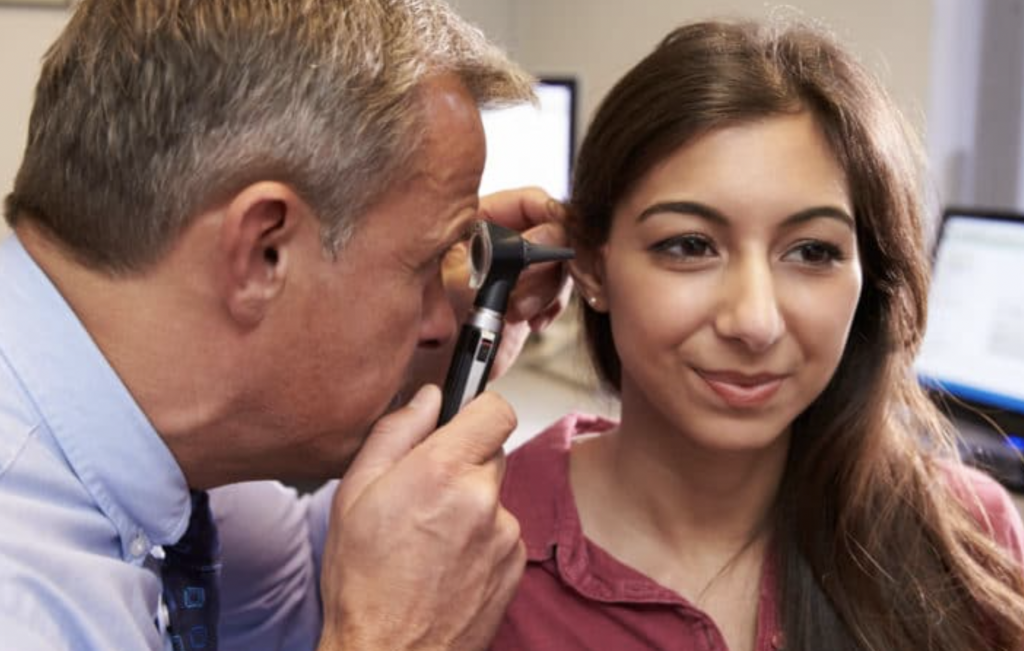Do you know why you need a normal intact eardrum for your ear to stay healthy? The eardrum consists of a special ear membrane which vibrates to conduct sound to help you to hear well. The eardrum also acts as a barrier to protect the delicate inner ear structures from infection. When the eardrum suddenly ruptures, the risk of ear infection is greatly increased, leading to hearing loss, smelly ear discharge, dizziness and imbalance. You might also notice disturbing ringing or buzzing noises, called tinnitus. Eardrum rupture may also lead to earache if there is underlying infection.
Ear Nose Throat (ENT) specialists in Singapore often see many patients who have perforated or burst their eardrums, commonly after a severe ear infection. Here, the eardrum ruptures due to the pressure buildup of infected fluid behind the eardrum, releasing this fluid into the ear canal as purulent ear discharge. This can in turn spread infection to the outer ear canal. In other cases of eardrum rupture, this might have happened after difficulty trying to equalise the middle ear pressures, such as during a flight, especially when landing or undertaking water sports such as scuba diving. Forcing your eardrums to “pop” by blowing your nose with the nose pinched shut, will lead to extremely high nasal pressures which, if transmitted via the Eustachian pressure tubes connecting to your ears, may lead to a sudden wave of high pressure that injures and hence “bursts” your eardrum (FIGURE 1).
Figure 1: A HUGE HOLE OR PERFORATION IS SEEN HERE IN THE RIGHT EARDRUM, WITH ACTUALLY VERY LITTLE EARDRUM REMAINING. THE DEEPER EAR STRUCTURES SUCH AS THE EAR BONES (OSSICLES) (yellow arrow) ARE USUALLY PROTECTED BY A HEALTHY INTACT EARDRUM. THEY SHOULD NOT BE VISIBLE DURING AN EXAMINATION OF A HEALTHY EAR.
In Singapore, many people enjoy water sports but if water enters the ear through the nose and back up the Eustachian pressure tubes, then this may cause eardrum infections. The Eustachian pressure tube can become congested and inflamed due to existing nasal allergies (allergic rhinitis), sinusitis and viral inflammation from the common cold or influenza (the “flu”). Importantly, the Eustachian pressure tube remains closed in its resting state most of the time and only opens up at the right time for a split second, in response to various pressure changes at the back of the nose (FIGURE 2).
FIGURE 2: THIS SHOWS THE BACK OF THE NOSE, WITH THE OPENING OF THE EUSTACHIAN TUBE SEEN ON THE RIGHT (blue arrow).
Barotrauma (pressure-related injury) can lead to a ruptured eardrum, most commonly during water sports such as scuba diving, where divers can descend to depths of greater than 20 metres under the sea. If you suffer sudden ear pain, ringing tinnitus in the ear, dizziness, hearing loss and bleeding from the ear during or after water sports, then you may be suffering from ear barotrauma. Sometimes, you merely notice an ear “popping” sound or may even be completely unaware that your eardrum has perforated, until an ENT specialist in Singapore examines your ear to discover the eardrum has ruptured with a hole now visible inside.
Ruptured eardrums which fail to heal up on their own should be repaired surgically to maintain a healthy ear free of infection and to ensure normal hearing once again. The ruptured eardrum is repaired by harvesting a healthy piece of tissue, called a “graft”, from the muscle behind your ear or the lining of the cartilage “bump” in front of your ear. For the best ENT doctors in Singapore who perform ear surgery very often, this is one of their favourite surgeries to perform because there is an extremely high success rate with tympanoplasty or myringoplasty, the name of the procedure used to surgically repair the eardrum, as high as 98-99% success rate in uninfected eardrum perforations. This may be done through the ear canal, sometimes endoscopically with a small camera (“keyhole surgery”), but also by making a small incision in the ear canal or going behind the ear for more complicated larger eardrum perforations with scarring.
Many hearing aid users find it difficult to use their hearing aid if they have a ruptured eardrum which keeps getting infected to cause a wet discharging ear. The hearing aid will not work well and becomes contaminated with bacteria from infected fluid draining from the perforated eardrum. So if you need to wear a hearing aid, then you should consider having your ruptured eardrum repaired first to give you a dry safe ear with an intact healthy eardrum.
The 3 important reasons to consider surgery to repair your ruptured eardrum are:
- To prevent further ear infections and stop the smelly yellow ear discharge
- To improve your hearing
- To give you a water-safe ear so that you can swim and dive again as before
5 things you need to know about eardrum rupture:
- Eardrum rupture may be caused by Eustachian pressure tube problems related to a tumour growing at the back of the nose, so you should always have your postnasal space checked out by your ENT specialist.
- Many ruptured eardrums may heal on their own, usually within 6-8 weeks, provided there is no longer any underlying infection.
- If your ruptured eardrum hasn’t healed in 6-8 weeks, it is much less likely to ever heal on its own. This means any water entering your ear may result in an ear infection, without the presence of an intact eardrum to protect the inner ear structures.
- Eardrum perforations are often associated with mild to moderate conductive hearing loss. If the hearing loss is much worse than that expected for just a perforated eardrum, then there may be issues with the ear bones (ossicles) or the inner ear nerve endings.
- Never dig your ears as ear-digging may lead to accidental rupture of the eardrum through direct injury with the digging tool!

